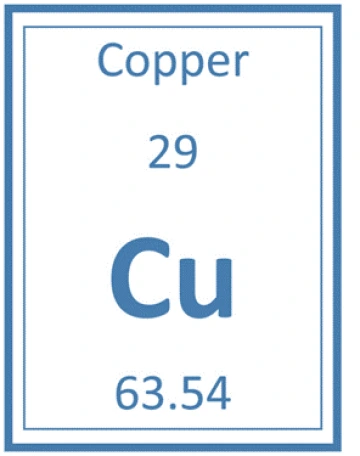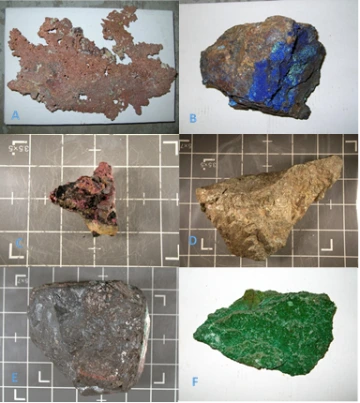
Copper is a chemical element in the periodic table with the symbol Cu (from the Latin word cuprum, meaning ‘metal of Cyprus,’ where it was mined during the Roman era). Copper has an atomic number of 29 and atomic weight of 63.54 grams per mole. It is an element in Group 11 of the periodic table, sharing many properties with silver and gold. In its standard state at room temperature, copper is solid. Copper is reddish-orange and has a bright metallic luster. With weathering, copper can become coated in a dull-green tarnish of copper carbonate called verdigris. One famous example of this is the Statue of Liberty, which is coated with 60,000 pounds of copper sheeting that has weathered to verdigris. Copper is also an essential micronutrient, meaning it is an essential dietary element in very tiny concentrations for plants and animals, including humans.
In its pure form, copper is relatively soft, and is malleable and ductile, meaning that it can be shaped or molded without breaking; for example, hammered flat into sheets or drawn out into wires. Copper is resistant to corrosion, and is a good conductor of heat and electricity (second only to silver). Because it is an element, copper can be perpetually recycled, without losing its properties. These properties can be adapted for specific uses based on whether it is used alone or alloyed (mixed with other elements). The most common copper alloys are bronze (copper and tin) and brass (copper and zinc), which are harder and stronger than copper.

The different forms of copper. A) Native copper; B) Azurite; C) Cuprite; D) Chalcopyrite; E) Chalcocite; and F) Malachite. Photo Credit: Arizona Geological Survey.
Naturally Occurring Forms of Copper
Copper deposits were formed by the action of hot waters, commonly associated with volcanism but also with sediments, and can be found around the world on every continent. Copper can be found in the earth’s crust as pure native copper, but mostly occurs in combination with other elements. Native copper is typically found as irregular masses or veins, which fill fractures and other spaces in the earth’s crust. When found in combination with other elements, copper can occur in minerals including copper sulfides (e.g., chalcopyrite and chalcocite), copper oxides (e.g., cuprite), copper carbonates (e.g., azurite and malachite), copper phosphates (turquoise), and additional mixed copper ores. Such ores can be quite complex, containing a variety of other non-metallic minerals, as well as metals and other elements (which for the purpose of copper extraction are considered wastes). Within an ore, copper concentration is commonly less than 1%. Each of the different natural forms of copper requires distinct mining and processing steps that eventually lead to 9.99% pure copper.
Historical and Modern Copper Use
The development of copper has a rich history. Copper has been used for thousands of years; it may have been discovered as early as 9000 BC in the Middle East. Early artifacts discovered were made of native copper and included utensils, tools, weapons, piping, ornaments, and jewelry. The largest deposit of native copper discovered to date was found in Michigan at the Keweenaw mines (Wood, 2001). Native Americans mined copper in this area between 5000 and 1200 BC, as evidenced by copper knives, arrows, spearheads, and axes. These types of artifacts have also been found throughout North and South America.
Copper smelting, or the use of heat and chemical reactions to extract the metal from an ore, appears to have been discovered independently in different parts of the world. A rise in the use of smelted copper defines the Chalcolithic period (from the Greek words khalkos and lithos, meaning ‘copper’ and ‘stone,’ respectively), which occurred between the end of the Stone Age and the advent of the Bronze Age (approximately 3500-2500 BC). Smelting of ores containing both copper and tin likely led to the discovery of the alloy bronze, which is easier to cast, and allowed a greater variety of materials to be made, including figurines and vessels. The addition of zinc vapor via calamine ore allowed the production of brass (often for decorative purposes), which became popular in the Roman World during the first millennium BC. Copper’s use as currency also came into prominence in the Roman World in 280 BC as brass coins and in 23 BC as copper coins.
Today, copper and its alloys have a variety of uses that impact our daily lives. To give some examples, the average U.S.-built automobile contains 50 pounds of copper, and the average U.S.-built home contains 400 pounds of copper. The five major uses of copper are: 1) building construction, 2) electrical and electronics, 3) general consumer products, 4) industrial machinery and equipment, and 5) transportation equipment. In addition, copper is antimicrobial, and may be used in personal products such as socks, as well as handles used in hospitals, and tables used in kitchen restaurants.
Type of market | copper consumption | examples |
|---|---|---|
Construction | 2,233 | Wiring, heating/refrigeration, and plumping |
Electrical & Electronics | 978 | Power utilities, cellphones, computers, lighting, and anything with an on/off switch |
Consumer & General Products | 627 | Currency, cookware, household appliances, coins, etc. |
Transportation Equipment | 982 | Airplanes, cars, trucks, trains, etc. |
Industrial Equipment | 378 | Manufacturing machinery, on-site equipment, off highway vehicles, and transmission lines |
Copper alloys are also used to make important and common instruments and tools. For example, bronze (copper and tin) is used to make durable tools (e.g., hammers), musical instruments (e.g., cymbals), ornaments, medals, statues, and bearings of various machines. In addition, brass (copper and zinc) is used to make musical instruments (e.g., horns) and decorative art (e.g., sculptures), and low friction (e.g., locks) and non-sparking tools (e.g., for use around explosive gases).
Worldwide consumption of copper has increased greatly over the past century as the world has developed. Currently, Asia is the leading world consumer of copper while Europe and the Americas take second and third place respectively (IWCC, 2013). Worldwide, Chile is the largest producer of copper (5.7 million tons per year), followed by China (1.7 million tons), Peru (1.3 million tons), the United States (1.2 million tons), and Australia (1 million tons) (USGS, 2014). In the United States, approximately 99% of the $9 billion dollars’ worth of copper produced annually comes from five states: Arizona, Utah, New Mexico, Nevada, and Montana (USGS, 2014). Building and construction markets typically utilize a large portion of the copper around the world. Yet, individually we also contribute to the active mining of copper due to our use of consumer products. A person born today is expected to use nearly ¾ of a ton of copper in his/her lifetime (Harmon et. al., 2013). Some of this copper is newly mined, and some is from recycling of copper used before by others.

